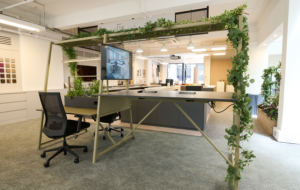|
|
||
|
My memory of the Venice architecture biennale this year is of a lot of people looking very relieved. Relieved that they didn’t have to think too much, relieved that there was a general consensus that the biennale was very nice, and though architects aren’t so great at conceptual art, it was quite atmospheric and at least the title of the exhibition had the word “people” in it. When things did get complex, people got uppity. The British Pavilion, a layered, complex and ambitious installation by Muf Architecture/Art (which I had a hand in selecting as a member of the British Council’s jury), was derided by a particular section of the British criterati as “not immediate enough”. Grown adults who bothered to make the trip from London to Venice were effectively wandering around muttering “I don’t get it” and “I’m bored”. Pritzker Prize-winning Japanese architect Kazuyo Sejima of Tokyo practice SANAA has curated the 2010 Venice architecture biennale under the title People Meet in Architecture. Sejima is the first woman to do the job, and the first Japanese, and the result can be seen through the lens of her own work – it is very abstract and it’s all about subjectivity. Yuko Hasegawa, the curator at the Sejima-designed Kanazawa Art Museum, says in her hagiography in the Venice catalogue: “At the beginning of her career, Sejima responded to the sheer weight of the cosmology of architecture (which left her more or less nonplussed) by wondering if it might not be possible to also achieve through architecture the gentle floating sensation of wearing a skirt.” Finding history and philosophy bewildering, she looked in the mirror and discovered an ambition to make architecture like her Issey Miyake skirt. Cheap shot, I know. Her architecture is better than that. But it is light, and insubstantial in good and bad ways. When I visited Kanazawa Art Museum for this magazine in 2005 (icon 020), it was an experience of a building with a highly abstract plan of white boxes inside a perfect circle of glass, wilfully ignoring the magical and historic Kenrokuen gardens opposite the site. It is architecture as tranquiliser dart, an architecture that says, in all its ideality: “Relax, it’s all going to be ok.” In the end, I have a strong suspicion that the reason everyone loves her work lies little further than good taste. And it’s so tedious to see people who stand outside this paradigm co-opted by it. Take Rem Koolhaas. He was awarded the Golden Lion in Venice this year, the lifetime achievement architecture Grammy that ensures the big names show up for the vernissage. In the citation, Sejima, whose architecture is, you must agree, completely different to the Dutchman’s, said: “Rem Koolhaas has expanded the possibilities of architecture. He has focused on the exchanges between people in space. He creates buildings that bring people together and in this way forms ambitious goals for architecture.” I wonder what the Koolhaas of Exodus, his Architectural Association graduation project of 1972, would make of that epitaph. He has gone from making a dystopia that proposed deliberately keeping people apart, to being included in the most banal, inclusive category possible: “Architects who create buildings that bring people together.” This of course bears on the whole notion of politics today. You can’t criticise something huge and general and all-inclusive. Big Tents have a horrible way of including even the most marginal of critics. The docile, it’s-all-quite-nice attitude of the people I chatted to over Spritz this year in Venice is the result. Well, here goes nothing. The Arsenale was not good, it was even offensive, and our consensus about it is very dangerous. In some kind of order – room #1: the very talented Chilean architect Smiljan Radic made a big rock with a hole in it, and described it as “one example of a protected interior that could be used to sleep [sic] if we want, just as a homeless person would, by visitors”. This confirmed my growing suspicion that these young Chileans have probably built too many houses in the hills for rich clients. With a staggering lack of empathy, it was a harrowingly subjective, middle-class response to an earthquake in Chile earlier this year that killed 561 people. Room #2, Wim Wenders: as if to emphasise the fuzzy reality of how the sloping floors and doughnut circulation of SANAA’s Rolex-sponsored university building in Lausanne, Switzerland (icon 083), aid students in learning things, Wenders made a 3D movie of Sejima and SANAA partner Ryue Nishizawa touring the building by Segway two-wheeler personal transporters. Perhaps the Segways were an ironic statement about this kind of architecture’s immediate obsolescence, but I doubt Wenders is that ironic, to be honest. Meanwhile, very attractive actors (nice to see a building photographed with beautiful people in it) whisper sweet nothings to the soffits. Room #4: the most conventional room was also the most difficult to understand, with construction drawings and a model of a complicated and ugly house by Architecten de Vylder Vinck Taillieu. It was designed for the Ordos project in China, where 100 new young starchitects-in-waiting, anointed by Jacques Herzog and Ai Weiwei, are designing houses. Sejima may have been subverting her own theme here: “People meet in Inner Mongolia in an incredibly expensive and bespoke house for a rich person.”
On to room #5, which was full of a cloud designed by Transsolar and Tetsuo Kondo. Perhaps I was lucky to be one of the few who saw the Blur Building (Diller Scofidio & Renfro’s temporary pavilion in Neuchatel, Switzerland, 2002) for real, but this dry ice version didn’t thrill me and suffered by comparison. The very positive effect of the installation, though, was that after experiencing the helical, high-level walkway and enfolding yourself in the cloud, the descent made everything feel relatively cool and dry – very useful in Venice in August. Studio Mumbai, fresh from its installation at the Victoria and Albert Museum in London, occupied room #7 with materials and tools from Mumbai. I couldn’t shake the feeling that it would have been more useful if the objects had stayed there. Room #9 by R&Sie(n) looked like a refugee from the Asymptote installation of 2002 and was consistently the emptiest room I went into. Room #10 was the place to come to get your superstars, as Hans Ulrich Obrist, the interviewing machine, created another unconsumable, vast archive of talking heads of dramatically varying quality. But quality control has never been his strong point. I’ve missed a few and could go on (Walter Niedermayr’s fabulous photographs of contemporary Isfahan, Olafur Eliasson’s jolly hoses, Tony Fretton and Mark Pimlott’s plasterboard De Chirico, Wang Shu’s so-bad-it’s-bad timber dome, the astonishing and quite exciting anti-context arrogance of Valerio Olgiati, and Janet Cardiff’s choir for narcissists), but you get the idea. I’m trying to make the point that there are extreme views to be had about this biennale, but mediating everything was Sejima’s pacifying good taste and her elegantly pitched selection of contributors. The Arsenale experience was like the moment after you’ve drunk three or four whiskies but before the alcohol has entered your bloodstream. It was more like Xanax than any drug that’s fun to take. Like SANAA’s buildings, really. There were loads of great things too, of course, more than it’s possible to include here. The international pavilion in the Giardini was full of exhibits you really want to spend time with (Lina Bo Bardi, Cedric Price, Christian Kerez, ARU, even OMA’s provocative diatribe about heritage), and I wouldn’t want this review to dissuade anyone from going there and seeing it all. But think, when you’re in the pub and everyone’s agreeing for the umpteenth time that Sejima’s really, really good. It’s just good taste Japanese modernism and is built better than most things in Europe. That’s all. I left wondering where the troublemakers have gone in our architectural culture, such as the late Lina Bo Bardi and Cedric Price. They’re not in Venice, either among the press corps or the exhibitiors. The comfortable allure of Sejima’s beautifully detailed big tent was so strong that everyone seems to have forgotten to look for meaning inside it.
|
Image Sergio Pirrone
Words Kieran Long |
|
|
||
|
|
||

















